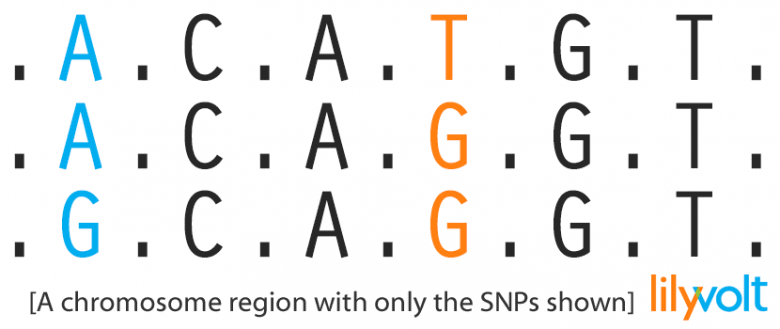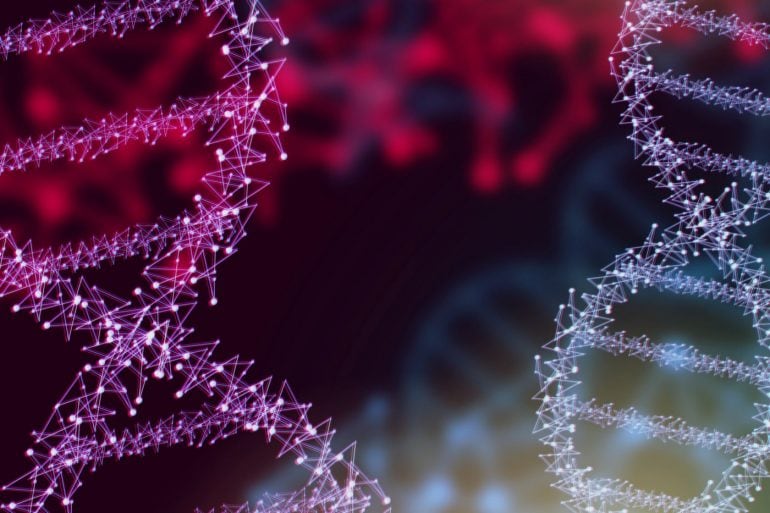Most common illnesses and diseases — everything from cancer to diabetes, stroke to heart disease, depression to schizophrenia, allergies to asthma — are affected by both genes and environmental factors.
Although any two unrelated people have about 99.9% of the same DNA sequences, the remaining 0.1% is important, because that is where the genetic variants live — those things that influence how people differ in their risk of health issues or their response to medications.
Discovering the DNA sequence variants that contribute to common disease risk offers one of the best opportunities for understanding the complex causes of diseases and other disorders in humans.
What is a genome?
A genome is an organism’s complete set of deoxyribonucleic acid (DNA), which is the chemical compound that contains the genetic instructions needed to develop and direct the activities of every organism.
DNA molecules are made of two twisting, paired strands. Each strand is made of four chemical units, called nucleotide bases. The bases are adenine (A), thymine (T), guanine (G) and cytosine (C), and bases on opposite strands pair specifically — a C always pairs with a G, and an A always pairs with a T.
In humans, the genome consists of 23 pairs of chromosomes, found in the nucleus, as well as a small chromosome found in the cells’ mitochondria (mtDNA). These chromosomes, taken together, contain approximately 3.1 billion bases of DNA sequence.
Methods to interpret this data is very much on the leading edge of science, particularly when you consider that the entire human genome was only all-but-completely sequenced in 2003. That’s why much of the information we have is anecdotal, or based on results of small research studies.
SNPs: Tiny changes, big differences
Single nucleotide polymorphisms, frequently called SNPs (pronounced “snips”), are the most common type of genetic variation among people. Each SNP represents a difference in a single DNA building block, called a nucleotide.
For example, a SNP may replace the nucleotide cytosine (C) with the nucleotide thymine (T) in a certain stretch of DNA. Each form is called an allele — one of two or more versions of a gene.
An individual inherits two alleles for each gene, one from each parent. If the two alleles are the same, the individual is homozygous for that gene. If the alleles are different, the individual is heterozygous.
SNPs occur normally throughout a person’s DNA. They occur once in every 300 nucleotides on average, which means there are roughly 10 million SNPs in the human genome. Most commonly, these variations are found in the DNA between genes. One allele, typically either the most commonly occurring allele or the allele originally sequenced, is considered the wild type, and the alternative allele is considered the variant allele.

What can SNPs tell you?
Single nucleotide polymorphisms can act as biological markers, helping scientists locate genes that are associated with disease. When SNPs occur within a gene or in a regulatory region near a gene, they may play a more direct role in disease by affecting the gene’s function.
Most SNPs appear to have no effect on health or development. Some of these genetic differences, however, have proven to be very important in the study of human health. Researchers have found SNPs that may help predict an individual’s response to certain drugs, susceptibility to environmental factors such as toxins, and risk of developing particular diseases. SNPs can also be used to track the inheritance of disease genes within families. Future studies will work to identify SNPs associated with complex diseases such as heart disease, diabetes, and cancer.
Those little letter variants can mean a lot in your life… or might simply explain some interesting little quirks you may have noticed.
- On the SNP rs1121980, a C/C result makes you at average risk for obesity — while a C/T result increases your risk approximately 1.67 times, and a T/T variant makes your risk 2.76 times higher.
- On the SNP rs4244285, G/G is normal, while both the A/A and A/G variants mean you will probably metabolize several popular medicines poorly, and have a higher risk for certain heart issues.
- On the SNP Rs17822931, a C/C result means you have wet earwax, while those with a T/T result have dry earwax (and are probably Asian).
Research is ongoing, but those little bits of DNA may be able to tell you if you are more or less likely to:
- taste bitterness
- go bald
- get Alzheimer’s disease
- have risk factors for of OCD, ADHD, bipolar disorder, autism
- be more or less affected by alcohol
- increased risk for heavy alcohol consumption
- suffer from nausea after surgery/anesthesia
- be lactose-intolerant
- suffer from gluten sensitivities or Chron’s disease
- be more stimulated by coffee
- risk of nicotine dependence and cocaine dependence
- your response to stress
- risk of various types of cancer
- whether you’re likely to be taller or shorter than average
Several popular direct-to-consumer personal genomics/biotechnology companies (such as 23andMe and Family Tree DNA) offer SNP genotyping — basically, they examine your SNPs, and return a report with your raw data.
How the pieces fit together
Each person has two copies of all chromosomes, except the sex chromosomes. The set of alleles that a person has is called a genotype.
For the SNP example shown at right, a person could have the genotype AA, AG, or GG. The term genotype can refer to the SNP alleles that a person has at a particular SNP, or for many SNPs across the genome. A method that discovers what genotype a person has is called genotyping.
About 10 million SNPs exist in human populations, where the rarer SNP allele has a frequency of at least 1%.
A set of associated SNP alleles in a region of a chromosome is called a haplotype — a set of DNA variations, or polymorphisms, that tend to be inherited together. A haplotype can refer to a combination of alleles, or to a set of single nucleotide polymorphisms (SNPs) found on the same chromosome.
Most chromosome regions have only a few common haplotypes (each with a frequency of at least 5%), which account for most of the variation from person to person in a population. A chromosome region may contain many SNPs, but only a few “tag” SNPs can provide most of the information on the pattern of genetic variation in the region.
Researchers trying to discover the genes that affect a particular disease, such as diabetes, can compare a group of people with the disease to a group of people without the disease. Chromosome regions where the two groups differ in their haplotype frequencies might contain genes affecting the disease.








